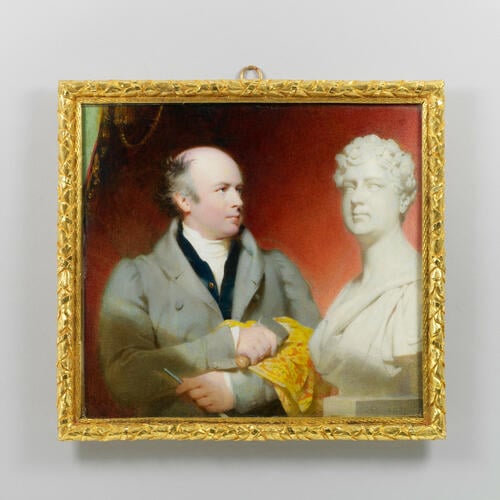Francis Chantrey (1781-1841) Signed and dated 1831
Watercolour on ivory | 13.6 x 14.5 cm (sight) (sight) | RCIN 420823
-
Sir Francis Chantrey (1781-1841), the son of a tenant farmer and carpenter, initially trained with Robert Ramsay, a carpenter, gilder and dealer in prints, then worked as a portrait painter and sculptor in Sheffield and London. A Sheffield journalist described him as ‘a modest, unassuming, well-behaved young man’. He became an Associate of the Royal Academy (A.R.A.) in 1816 and a Royal Academician (R.A.) in 1817, and rose to be the most distinguished monumental sculptor of his day. He was knighted by William IV in 1837. Henry Weekes, his assistant, explained that the public thought that ‘an artist had arisen who took an original, and at the same time common sense view of portraiture: who could give the inward mental character of those who sat to him, and portray them as men of the age in which they lived;—could, in short, bring together the modern type of face and good Art, and make them both agree’. In this miniature he is standing next to his bust of George IV – of which he produced 18 versions. Chantrey also sculpted a full-length standing figure of George IV which is now in Windsor Castle. When it was completed the king is said to have commented: ‘Chantrey, I have reason to be obliged to you, for you have immortalised me’. Sir Walter Scott described Chantrey as ‘blunt & honest & open without any of the nonsensical affectation so common amongst artists’. When he died, Chantrey left his large fortune to the Royal Academy for the purchase of works of art executed in Great Britain, known as the Chantrey Bequest.
The portrait was greatly admired by contemporaries and it reflects Andrew Robertson’s (1777-1845) new approach to the concept of the miniature and his development of painting technique. Although this is painted in watercolour on ivory, Robertson sought to imitate the high gloss finish of oil painting, producing highly finished pictures and adding gum with varnish in the later stages to enrich the colours and give depth and glossiness to the image. They were very different from the miniatures by Richard Cosway and his contemporaries which Robertson described as ‘lacking in nature, colouring and force’. He also often used square-shaped ivories as his base for portraits, rather than the traditional oval, because he wanted his pictures to be framed and hung rather than worn as lockets. This miniature was typical of his ‘new large style’ and, in 1802, he was delighted his pictures ‘had the most conspicuous place at the [Royal Academy] exhibition, in the very centre,’ and the workmen who were putting up the paintings informed him that his were ‘the very first miniatures that were hung up’.
Andrew Robertson was born in Aberdeen, the son of an architect. He was very musical and became director of concerts in Aberdeen at the age of 16. He taught drawing, miniature painting and portraiture and received his Master of Arts in 1794 in Aberdeen. In 1801, Robertson went to London and entered the Royal Academy Schools, exhibiting in London and Edinburgh between 1802 and 1842. In 1805, he was appointed miniature painter to the duke of Sussex and exhibited portraits of him as lieutenant colonel of the Loyal North Britons, a volunteer regiment raised to repel Napoleon's threatened invasion of England. In 1807, he became secretary of the newly-founded society, the Associated Artists in Water Colour, where he exhibited portraits of the princesses in 1808.
The miniature is signed and dated on the marble socle (plinth at the base of the statue): AR [monogram] 1831.
Provenance
Bought by Queen Victoria in 1880
-
Creator(s)
Acquirer(s)
-
Medium and techniques
Watercolour on ivory
Measurements
13.6 x 14.5 cm (sight) (sight)
15.2 x 16.3 cm (frame, external)









